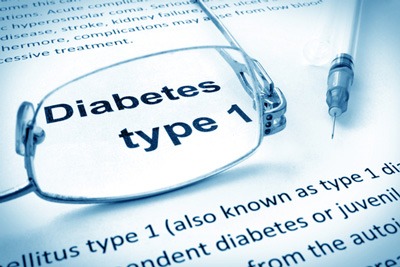For adults or children diagnosed with Type 1 diabetes (the pancreas does not produce insulin and one needs to inject insulin for life), it is important to know how to manage what you eat and your activity level in relation to insulin.

Manage Type 1 Diabetes & Diet
What you eat is a priority when managing your type 1 diabetes. Why? Because the minute you eat foods that raise blood sugar, you must be ready to manage the spike.
While this sounds simple, it is not easy. If you think you can just eat carbohydrates and then bolus insulin, think again. For many, it is the catalyst for having to chase the high’s and low’s of blood sugar on a daily basis.
Predicting Insulin Interactions in Type 1 Diabetes
In order to be successful you need to understand and manage the dynamic between the absorption rate of both insulin and the amount and type of carbs consumed. Ideally, insulin is most effective when it peaks at the time your food is absorbed. Accurately predicting this is close to impossible because individuals are unique when it comes to metabolizing and absorbing food and insulin. For example:
- Different types of carbohydrates are absorbed at different rates. While you are taught to cover all carbohydrates equally. There can be as much as a 50% difference in the rate of absorption of various types of carbohydrates.
- Food labels can have as much as a 20% margin of error in their carbohydrate content claims.
- Insulin has a 30% difference in its rate of absorption.
So, when insulin and carbohydrate absorption are not in sync, you are set up to fail blood sugar management. Thus experiencing blood sugar highs and lows all day long. And then in addition, there are the accompanying emotional swings, frustration and stress of feeling like a failure. Minimizing carbohydrates, minimizes the the need for insulin therefore lowering the variability of both. Less variability gives you a much better chance to achieve target blood sugar.
Doctors Use A Ketogenic Diet In Type 1 Diabetes Care
Dr. Keith Runyan explains the phenomenon of variations in carbohydrate and insulin absorption. He is a physician who developed type 1 diabetes at the age of thirty-eight. His goal was to optimize his blood sugar control while engaging in endurance exercise. In 2012, Dr. Runyan used a low-carb, high-fat, ketogenic diet and found it was safe, effective and better than the conventional treatment. Now, he manages patients with type 1 diabetes using a ketogenic diet. In fact, Dr. Runyan completed an Ironman-distance triathlon while following a ketogenic diet.
Dr. Richard Bernstein has had type 1 diabetes for over 60 years and remains healthy. The basis of his recommendations for 30 grams of total carbohydrates a day (6 grams for breakfast, 12 grams for lunch and another 12 grams for dinner) to minimize insulin dose. He also believes that by reducing carbs and reducing insulin helps improve predictability.
The carbohydrate foods he suggests are salad greens and non-starchy vegetables. While avoiding most other carbohydrates such as sweets, starchy vegetables, fruits and juices, milk, low-fat yogurt, grains, pasta, and many types of prepared foods. There is a focus on consuming fats and proteins that do not significantly affect blood sugar levels.
Benefits of Using The Ketogenic Diet & Type 1 Diabetes
Using a ketogenic diet will provide energy and nutrients without the blood sugar spike for those who live with type 1 diabetes. When carbs are minimized and blood sugar is consistently normal, life expectancy and quality of life are similar to people who do not have diabetes. Type 1 diabetes is more easily managed with a clear thought process and more confidence in the success of blood sugar management.
When transitioning to a ketogenic diet from eating a high carbohydrate diet, seek help from a knowledgeable professional to help manage insulin dosing and potential low blood sugar.
3 Blood Sugar Monitoring Tricks For Type 1 Diabetes
While it may seem overwhelming, type 1 diabetes can be controlled if you understand a few important tips. In order to do this, follow these three tricks.
One, learn about low blood and high blood sugar triggers. Two, track the triggers. And three, analyze the data to provide solutions for dosing insulin.
Most people use a generalized formula to dose insulin. This regimen has you chasing blood sugar instead of managing it preventively. Chasing blood sugar is a losing battle and tiring to say the least.
Targeting insulin dose based on your personalized blood sugar history, food choices and experiences will help simplify Type 1 diabetes care.
Type 1 Diabetes Blood Sugar Triggers
Familiarize yourself with type 1 diabetes blood sugar triggers. These items trigger high or low blood sugar.
High Blood Sugar
- Foods, supplements, and beverages: While carbohydrates are well-known causes of high blood sugar, if you combine the carbs with fat (pizza, french fries,Chinese food), sports drinks, juices the effect is worse. Caffeine, artificial low-calorie sweeteners, and diet products can all raise blood sugar so read labels.
- Exercise/Activities such as household chores: lawn mowing, gardening, vacuuming
- Getting sick
- Pain (wound or sunburn)
- Medications: steroids, decongestants, and water pills
- Stress
- Birth control pills
- Hormones
- Hot climates
- Menstruation
- Lack of Sleep
- Exercise
- Dehydration
Low Blood sugar
- Alcohol
- Too much medication for the number of carbohydrates
- Prescription and non-prescription drugs/Medication
- Exercise or physical activity
- Menstruation
The chart below was found on Adam’s corner Diatribe. It provides a simple but detailed breakdown of 42 factors affecting type 1 diabetes blood sugar.
Check Blood Sugar Frequently and Consistently With Type 1 Diabetes. In order to gather needed blood sugar information, consider before and after results from meals, physical activity and any other factor that triggers changes in blood sugar.
Track, Track, Track Type 1 Diabetes Triggers
Yes, tracking triggers and blood sugar might be time-consuming at first. However, gathering data will be the best way of understanding your relationship with type 1 diabetes and the environment that influences blood sugar.
Once you are well versed with how different triggers affect your blood sugar, and you are living as consistently as possible, daily tracking will transition to spot checking. Start by downloading an app on your phone. Although KetoDiet.Com is not specific to diabetes, it is an excellent food and recipe resource for those who want to use a ketogenic diet to minimize insulin boluses and blood sugar excursions. Otherwise, you can create a spreadsheet. Using general logs may not work. Your personal log should reflect your life. Life consists of more than just insulin and food.
If you identify triggers that affect type 1 diabetes in the diatribe chart above, incorporate them into a personalized chart. For example, if you take allergy medicine or have monthly periods, that should be an item to track on your personalized log.
The information will help you better understand your insulin needs. Initially, you will need to track more often. Then as blood sugar normalizes consistently, you can spot check more often. Intense monitoring is not as necessary.
Analyze Blood Sugar Results Comparing Type 1 Diabetes Triggers
As you track blood sugar, review the results without judgment. When you live with type 1 diabetes, high or low numbers do not reflect pass or fail. They are not synonyms for good or bad.
High and low blood sugar numbers simply act as guides to help you tweak the hurdles that interfere with normal blood sugar levels.
Food, activity, stress and many different triggers affect your Type 1 diabetes. Target the areas you need to focus on to get blood sugars into normal ranges.
Set behavioral goals to get to long term goals. Have patience during this time. Change your plan as needed. What you think will work, may not. Take a close look at your blood glucose record to see if your level is too high or too low several days in a row at about the same time. If the results consistently do not fall in the normal range, it might be time to change your plan.
Actually, this is not an easy task. So Initially you may need to work with your doctor or diabetes educator. Once your blood sugar is consistent for at least a month or two, you can
Simplify Life With Type 1 Diabetes Wrap Up
Manage type 1 diabetes successfully. The goal is to normalize blood sugar. A healthy lifestyle is a consistent ketogenic eating pattern that minimizes insulin dose and blood sugar spikes. Therefore increasing blood sugar predictability. Also, it is helpful to identify and monitor triggers that raise blood sugar.
Thus helping to guide you on making lifestyle changes to support your goal. Physical health will support your mental and emotional state of being and significantly improve your quality of life.
As mentioned previously, consistency is a key element to normal blood sugars. As long as you are consistent, your blood sugar should be consistent too. Simplify life with these type 1 diabetes tools.






